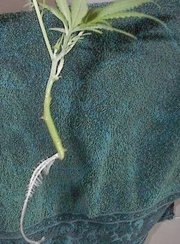Vegetative reproduction
|
|
Kalanchoe_veg.jpg
Vegetative reproduction is asexual reproduction, but other terms that apply are vegetative propagation and vegetative multiplication. In essence it is any process by which new plant "individuals" arise or are obtained without production of seeds or spores. It is both a natural process in many, many plant species (including organisms that may or may not be considered "plants", depending on which taxonomy is used, such as bacteria and fungi) and one utilized or encouraged by horticulturists to obtain quantities of economically valuable plants.
Natural vegetative reproduction is mostly a process of herbaceous and woody perennials, and typically involves structural modifications of the stem, although any horizontal, underground part of a plant (whether stem or a root) can contribute to vegetative reproduction of a plant. In a few species (such as Kalanchoë shown at right), leaves are involved in vegetative reproduction. Most plant species that survive and significantly expand by vegetative reproduction would be perennial almost by definition, since specialized organs of vegetative reproduction, like seeds of annuals, serve to survive typically seasonal harsh conditions. A plant that persists in a location through vegetative reproduction of individuals over a long period of time constitutes a clonal colony.
In a sense, this process is not one of "reproduction" but one of survival and expansion of biomass of the individual. (When an individual organism increases in size via cell multiplication and remains intact, the process is called "vegetative growth".) However, the new plants that result are new individuals in every respect but genetic. And of considerable interest is how the process appears to reset the aging clock.
Natural vegetative structures
A rhizome is a modified stem serving as an organ of vegetative reproduction. Prostrate aerial stems, called runners or stolons are important vegetative reproduction organs in some species, such as the strawberry, numerous grasses, and some ferns. Adventitious buds develop into above ground stems and leaves, forming on roots near the ground surface and on damaged stems (as on the stumps of cut trees). Adventitious roots form on stems where the latter touch the soil surface.
Horticultural aspects
Man-made methods of vegetative reproduction are usually enhancements of natural processes, but range from simple cloning such as rooting of cuttings to artificial propagation by laboratory tissue cloning. Fruit tree propagation is frequently by budding or grafting desirable cultivars (clones), onto rootstocks that are also clones, propagated by layering.
In horticulture, a "cutting" is a branch that has been cut off from a mother plant below an internode and then rooted, often with the help of a rooting liquid or powder containing hormones. When a full root has formed and leaves begin to sprout anew, the clone is a self-sufficient plant, genetically identical to the mother plant.
Cultivated Plants Propagated by Vegetative Methods
A number of commonly cultivated food plants are propagated by vegetative means rather than by seeds. This is a listing of such plants:

